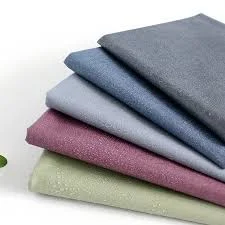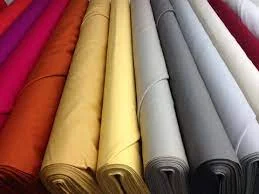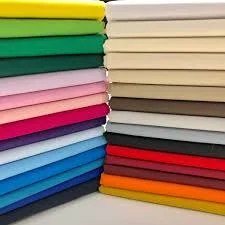-
Understanding Ratings: Abrasion, Flammability, and Lightfastness
When selecting fabrics for your projects, finding the right solid fabric is crucial. Understanding its characteristics, durability, and versatility can make a significant difference in the outcome of your creations. Whether you are a seasoned crafter or just starting in the world of textiles, mastering solid fabrics will elevate your projects to new heights.
Benefits of Using Solid Fabric
Timeless Appeal
Solid fabric offers a classic and enduring look that can elevate the ambiance of any room. You can rely on solid fabrics to maintain their elegance and charm over time, making them a timeless choice for your decor. They create a sophisticated atmosphere that never goes out of style.
Solid fabric serves as an excellent base for mixing and matching with other patterns or textures in your space. By incorporating solid fabrics into your decor, you have the freedom to experiment with various designs without overwhelming the visual appeal. Whether it's adding bold prints or intricate textures, solid fabric acts as a versatile backdrop that complements diverse styles seamlessly.

Minimalist Elegance
For those who appreciate simplicity and modern aesthetics, solid fabric is an ideal option. Embracing solid fabrics in your decor allows you to achieve a clean, minimalist look that exudes sophistication and elegance effortlessly. You can create a sleek and polished appearance by incorporating different shades of solid fabrics throughout your space.
-
Creates timeless appeal
-
Facilitates easy coordination with other patterns
-
Ideal for minimalist or modern aesthetic preferences
Solid Fabric Types and Their Applications
Cotton Fabric
Cotton solid fabric is a breathable material that works well for everyday use in upholstery and drapery. You can enjoy the comfort of cotton while adding a cozy feel to your living space. This type of fabric is easy to maintain, making it perfect for furniture pieces that see regular use.
For instance:
-
Upholstering your couch with cotton solid fabric can provide a soft and inviting seating option.
-
Using cotton drapery can help regulate temperature in your home while adding a touch of elegance.
Polyester Fabric
Polyester solid fabric, known for its durability, is an excellent choice for high-traffic areas due to its resistance to wrinkles. You can rely on polyester fabric to maintain its shape even with frequent use. This type of fabric offers longevity and ease of care, making it suitable for busy households.
Consider:
-
Decorating your dining chairs with polyester solid fabric covers that are both stylish and practical.
-
Opting for polyester curtains in rooms where sunlight exposure may cause other fabrics to fade quickly.
Choosing the Right Solid Fabric
Consider Intended Use
When choosing solid fabric, think about how you'll use it. If it's for a sofa, consider durability. For curtains, focus on light filtration.
Solid fabrics come in various weights and materials. For upholstery, opt for sturdy fabrics like canvas or denim.
Color Palette and Design Scheme
Your solid fabric should complement your space's color palette and design scheme. Match the fabric to existing furniture or decor elements.
You can choose a bold solid color to make a statement or go with neutral tones for versatility.
Easy Maintenance
Look for solid fabrics that are easy to clean if you have kids or pets at home. Fabrics labeled as machine-washable can be convenient.
Consider selecting from collections like the Free Spirit Essential Solids Collection known for quality and ease of care.

Solid Fabric for Upholstery and Drapery
Choosing the Right Type
When selecting solid fabric for upholstery, consider a durable material like polyester or microfiber. These fabrics are easy to clean and maintain, perfect for high-traffic areas. Opt for heavier fabric to ensure longevity in your furniture pieces.
For drapery, choose a solid fabric that complements your room's decor while providing privacy. Linen or velvet can add texture and depth to your windows, creating an elegant look. Ensure the chosen fabric is thick enough to block out unwanted light effectively.
Consider stain-resistant options when picking solid fabric for both upholstery and drapery in areas prone to spills or stains. Fabrics treated with stain-resistant finishes make cleaning up messes a breeze, keeping your furniture looking fresh and new.
Care Tips
To maintain the quality of your solid fabric, regularly vacuum upholstered furniture using a soft brush attachment to remove dust and debris. For spot-cleaning, use a mild detergent mixed with water on a clean cloth, gently dabbing at the stain without rubbing it further into the fabric.
For draperies made from solid fabric, follow care instructions carefully when washing them. Some fabrics may require professional dry cleaning to prevent damage or shrinking. Avoid using harsh chemicals that could strip away the color or finish of the material.
Care and Maintenance of Solid Fabrics
Cleaning Guidelines
Following the manufacturer's instructions is crucial. Use a mild detergent for cleaning, as harsh chemicals can damage the material. Vacuum or brush off dust regularly to prevent accumulation.
Maintaining solid fabrics involves treating stains promptly. Different types of solid fabrics require specific cleaning methods, so always refer to the guidelines provided by the manufacturer. Avoid using excessive water when cleaning solid fabrics to prevent potential damage.
Stain Removal Methods
To maintain your solid fabric, act quickly when dealing with stains. Blotting with a clean cloth is effective in removing fresh stains before they set into the fabric. For tougher stains, consider using specialized stain removers recommended for your type of solid fabric.
-
Use a mild detergent
-
Follow manufacturer's instructions
-
Vacuum or brush off dust regularly
-
Treat stains promptly
Understanding Ratings: Abrasion, Flammability, and Lightfastness
Checking Abrasion Rating
When selecting solid fabrics for your furniture, abrasion rating is crucial. This rating tells you how durable the fabric is against wear and tear. The higher the double rub rating, the more resilient the fabric will be to daily use.
Solid fabrics with a high abrasion rating are ideal for pieces that see heavy usage, like sofas or dining chairs. Ensure you choose a fabric that can withstand your lifestyle to ensure longevity.
Considering Flammability and Lightfastness Ratings
For public spaces or homes with fire safety concerns, it's vital to consider the flame spread index of solid fabrics used in upholstery. Fabrics with lower flammability ratings are safer choices for these settings.
Don't forget about light exposure when choosing solid fabrics. Lightfastness ratings indicate how well a fabric resists fading when exposed to sunlight over time. Opt for fabrics with high lightfastness ratings if your furniture will be placed in sunny areas.

![]()
Purchasing Options: Yardage vs. Bundles
Customization with Yardage
When you buy solid fabric by the yard, you have the advantage of tailoring the amount to fit your project perfectly. This option is ideal for larger projects where you need a specific quantity of fabric.
-
Customize the amount needed
-
Ideal for larger projects
Purchasing solid fabric by the yard gives you control over how much material you acquire, ensuring that there is enough for your project without excess waste. For instance, if you are making curtains or reupholstering furniture, buying by the yard allows precise measurements and cuts.
Convenience of Bundles
On the other hand, opting for bundles of solid fabric can be convenient when working on smaller projects or if you desire a variety of colors in smaller quantities. These pre-packaged bundles are often curated to offer complementary colors or different shades within a color family.
-
Convenient for small projects
-
Variety of colors available
If you enjoy quilting and need an assortment of fabrics without having to purchase large quantities individually, bundles provide a cost-effective solution. They are also suitable for crafters who like experimenting with different colors and textures in their creations.
International Shipment and Proposition 65 Considerations
Eligibility for International Shipment
Before purchasing solid fabric, ensure it is eligible for international shipment. Some sellers may have restrictions on shipping certain types of fabrics abroad due to customs regulations. Check with the seller about their shipping policies.
When ordering online, look for information on free shipping options or additional fees for international delivery. Make sure you understand the estimated transit days and any potential delays that might occur during the shipment process.
-
Verify eligibility for international shipment
-
Understand free shipping terms
-
Confirm transit days and possible delays
Proposition 65 Regulations in California
If you are in California and buying solid fabric, be aware of Proposition 65 regulations. This proposition requires businesses to provide warnings to Californians about significant exposures to chemicals known to cause cancer, birth defects, or other reproductive harm.
When purchasing solid fabric from a supplier based in California or selling products within the state, they must comply with Proposition 65 requirements by providing appropriate warnings if necessary.
-
Stay informed about Proposition 65 rules
-
Ensure compliance when buying from California-based suppliers
Final Remarks
Incorporating solid fabrics into your projects can elevate the aesthetics and functionality of your designs. Understanding the diverse types available, selecting the appropriate fabric for your needs, and maintaining it properly are crucial steps in ensuring long-lasting and visually appealing results. By considering factors like abrasion resistance, flammability ratings, and lightfastness, you can make informed decisions that enhance the durability and safety of your creations. Whether you are upholstering furniture, creating drapery, or engaging in other fabric-related endeavors, the right choice of solid fabric can significantly impact the outcome.
Take the time to explore different solid fabric options, delve into their applications, and familiarize yourself with care practices to optimize your projects. Your attention to detail and informed selections will not only enhance the quality of your work but also contribute to a seamless and enjoyable creative process.

Frequently Asked Questions
What are the key benefits of using solid fabric?
Solid fabrics offer durability, versatility, and timeless style for various applications. They provide a cohesive look, easy coordination with other patterns, and can withstand frequent use.
How to choose the right type of solid fabric for a specific application?
Consider factors like material composition, weight, texture, and intended use when selecting solid fabric. Consult with professionals or refer to manufacturer guidelines for tailored recommendations.
What are some common types of solid fabrics used in upholstery and drapery?
Common types include cotton canvas for durability, velvet for luxury appeal, linen for a natural look, and polyester blends for easy maintenance. Each type offers unique characteristics suitable for different needs.
Why is it important to understand ratings such as abrasion resistance and flammability when choosing solid fabrics?
Understanding these ratings ensures that the chosen fabric meets safety standards and can withstand its intended usage over time. It helps in making informed decisions based on quality and longevity considerations.
What are the primary differences between purchasing options like yardage vs. bundles when buying solid fabric?
Yardage allows flexibility in choosing specific amounts needed per project while bundles offer pre-cut quantities ideal for smaller projects or sampling purposes. Consider your project requirements to determine the most suitable option.
